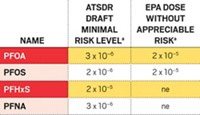Advertisement
Grab your lab coat. Let's get started
Welcome!
Welcome!
Create an account below to get 6 C&EN articles per month, receive newsletters and more - all free.
It seems this is your first time logging in online. Please enter the following information to continue.
As an ACS member you automatically get access to this site. All we need is few more details to create your reading experience.
Not you? Sign in with a different account.
Not you? Sign in with a different account.
ERROR 1
ERROR 1
ERROR 2
ERROR 2
ERROR 2
ERROR 2
ERROR 2
Password and Confirm password must match.
If you have an ACS member number, please enter it here so we can link this account to your membership. (optional)
ERROR 2
ACS values your privacy. By submitting your information, you are gaining access to C&EN and subscribing to our weekly newsletter. We use the information you provide to make your reading experience better, and we will never sell your data to third party members.
Environment
Review of Dioxin Reassessment Begins
November 29, 2004
| A version of this story appeared in
Volume 82, Issue 48
On Nov. 22, a National Academies panel met to begin a review of EPA's 2003 draft reassessment of the risks of TCDD (2,3,7,8-tetrachlorodibenzo-p-dioxin) and dioxin-like compounds. The review will focus on a number of topics, including the scientific basis for classifying TCDD as a human carcinogen and the validity of using a non-threshold linear dose-response model to calculate dioxin risks. At the meeting, William H. Farland, acting deputy assistant administrator for science in EPA's Office of Research & Development, upheld the agency's contention that TCDD is a human carcinogen and that dioxin-like compounds are likely carcinogens. He pointed out that, although industrial releases of dioxins have declined greatly in recent years, average body burdens of dioxins are within a factor of 10 of the equivalent levels that cause noncancer adverse effects, such as reproductive effects, in animals and humans. Representatives of chemical and food industries, however, said EPA's conclusions conflict with recent dioxin assessments by the European Commission and the World Health Organization, which consider dioxins less of a risk.





Join the conversation
Contact the reporter
Submit a Letter to the Editor for publication
Engage with us on Twitter